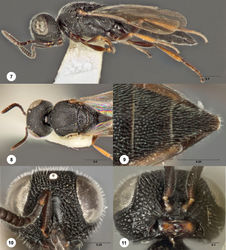Bracalba globosa
| Notice: | This page is derived from the original publication listed below, whose author(s) should always be credited. Further contributors may edit and improve the content of this page and, consequently, need to be credited as well (see page history). Any assessment of factual correctness requires a careful review of the original article as well as of subsequent contributions.
If you are uncertain whether your planned contribution is correct or not, we suggest that you use the associated discussion page instead of editing the page directly. This page should be cited as follows (rationale):
Citation formats to copy and paste
BibTeX: @article{Burks2012ZooKeys236, RIS/ Endnote: TY - JOUR Wikipedia/ Citizendium: <ref name="Burks2012ZooKeys236">{{Citation See also the citation download page at the journal. |
Ordo: Hymenoptera
Familia: Platygastridae
Genus: Bracalba
Name
Bracalba globosa Burks sp. n. – Wikispecies link – ZooBank link – Pensoft Profile
Description
Female. Body length 3.12–3.25 mm (n=2). Color of antenna beyond radicle: entirely dark. Radicle color: lighter than scape. Number of claval segments with ventral gustatory sensilla: 7. Number of ventral gustatory sensilla on A6: 2.
Ocular setae: short and dense. Frontal depression: smooth dorsally, torular triangle foveolate with 1 transverse carina extending laterally from inner margin of antennal foramen. Smooth depression extending dorsolaterally from antennal foramen: present. Dorsal clypeal margin: but without other sculpture. Clypeal median carina: absent. Ventral clypeal margin: with a small median point. Mandibular color: dark basally and at teeth, becoming lighter reddish brown between these areas. Mandibular teeth: two, separated by narrow incision. Smooth area obliquely posterior to lateral ocellus: present. Genal sculpture: reticulate-rugose without any strong carinae.
Dorsal pronotal area: not set off by carina ventrally. Anterolateral corner of dorsal pronotal area: weakly rounded anteriorly. Sculpture of posteromedian area of mesoscutum: foveolate with slightly stronger longitudinal septa. Lateral margin of dorsal axillar area: triangularly expanded or with posterior tooth, broadest posteriorly. Mesoscutellar sculpture: densely foveolate with slightly stronger longitudinal septa. Metascutellum in dorsal view: trapezoidal with broad apex. Dorsal surface of metascutellum: apex protruding dorsally. Femoral depression: crossed by rounded carinae. Leg color: dark except for tibiae, 2nd trochanter, and tarsomeres 2-5. Anterior corner of lateral propodeal carina: flat, without tooth. Posteromedial corner of lateral propodeal area: protruding posteriorly.
Metasoma color: black to dark reddish brown. Median lobe of T1: with a set of rugae that merge with one another. Metasoma at middle of T4: without bend. Posterolateral margins of metasomal terga: without protrusions. T5 median carina: absent. Longitudinal sculptural septa on T5: weak, blunt and hardly raised. Transverse sculptural septa on T5: about as strong as the longitudinal septa. T5 setae: directed posteriorly, arising from anterior edge of sculptural mesh. T6: as broad or broader than long. T6 laterotergite: overlapping S6. S4 median carina: absent. Transverse sculptural septa on S5: weak or absent, much weaker than the longitudinal septa. S5 setae: directed posteriorly, arising from anterior edge of sculptural mesh. Lateral carinae of S6: absent. Apex of S6: without notch.
Male. Body length 2.88 mm (n=1). Flagellomere length: A3 over 1.5× as long as broad, most others as long or longer than broad. T7: flat and posteriorly truncate.
Diagnosis
Female. A6 with 2 large ventral sensilla; 2 mandibular teeth; anterolateral corner of dorsal pronotal area weakly rounded anteriorly; metascutellum trapezoidal with a broad apex, extending dorsally; metasomal bend absent; T4–T6 without median carina, S4–S6 without median carina; T6 broader than long; S6 without apical notch. Bracalba globosa is very similar to Bracalba cuneata, but differs mainly in mesosomal shape and sculpture. The metascutellum also differs subtly between most specimens of the two species, being smaller in most Bracalba globosa. Bracalba plana is also very similar to Bracalba globosa, but has a very different mesosomal shape.
Etymology
Latin adjective, named after the convex mesoscutum of most specimens in this species.
Link to distribution map
http://hol.osu.edu/map-full.html?id=302153
Material examined
Holotype, female: AUSTRALIA: WA, Kalbarri National Park, 12.XII-19.XII.1986, malaise trap/pan trap, J. S. Noyes, OSUC 148701 (deposited in WAMP). Paratype: AUSTRALIA: 1 female, OSUC 148612 (CNCI).
Original Description
- Burks, R; Masner, L; Johnson, N; Austin, A; 2012: Taxonomic revision of Bracalba Dodd (Hymenoptera, Platygastridae s.l.), a parasitoid wasp genus endemic to Australia ZooKeys, 236: 1-53. doi
Images
|
